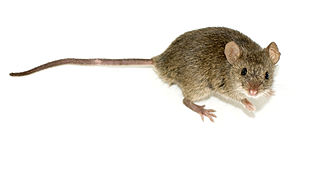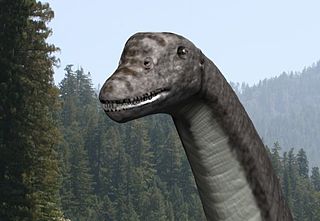
A mouse, plural mice, is a small rodent. Characteristically, mice are known to have a pointed snout, small rounded ears, a body-length scaly tail, and a high breeding rate. The best known mouse species is the common house mouse. Mice are also popular as pets. In some places, certain kinds of field mice are locally common. They are known to invade homes for food and shelter.

Pterodactylus is an extinct genus of pterosaurs, whose members are commonly known as pterodactyls. It is thought to contain only a single species, Pterodactylus antiquus, which was the first pterosaur to be named and identified as a flying reptile.

Pteranodon is a genus of pterosaur that included some of the largest known flying reptiles, with wingspans over 7 meters. They lived during the late Cretaceous geological period of North America in present-day Kansas, Alabama, Nebraska, Wyoming, and South Dakota. More fossil specimens of Pteranodon have been found than any other pterosaur, with about 1,200 specimens known to science, many of them well preserved with nearly complete skulls and articulated skeletons. It was an important part of the animal community in the Western Interior Seaway.

Stegosaurus, from Greek stegos (στέγος), which means roof, and sauros (σαῦρος), which means lizard, is a genus of herbivorous thyreophoran dinosaur. Fossils of this genus date to the Late Jurassic period, where they are found in Kimmeridgian to early Tithonian aged strata, between 155 and 150 million years ago, in the western United States and Portugal. Of the species that have been classified in the upper Morrison Formation of the western US, only three are universally recognized; S. stenops, S. ungulatus and S. sulcatus. The remains of over 80 individual animals of this genus have been found. Stegosaurus would have lived alongside dinosaurs such as Apatosaurus, Diplodocus, Brachiosaurus, Allosaurus, and Ceratosaurus; the latter two may have preyed on it.
Old World warblers are a large group of birds formerly grouped together in the bird family Sylviidae. The family held over 400 species in over 70 genera, and were the source of much taxonomic confusion. Two families were split out initially, the cisticolas into Cisticolidae and the kinglets into Regulidae. In the past ten years they have been the subject of much research and many species are now placed into other families, including the Acrocephalidae, Cettiidae, Phylloscopidae, and Megaluridae. In addition some species have been moved into existing families or have not yet had their placement fully resolved. A smaller family of warblers, together with some babblers formerly placed in the family Timaliidae and the parrotbills, are retained in a much smaller family Sylviidae.

Dilophosaurus is a genus of theropod dinosaurs that lived in what is now North America during the Early Jurassic, about 193 million years ago. Three skeletons were discovered in northern Arizona in 1940, and the two best preserved were collected in 1942. The most complete specimen became the holotype of a new species in the genus Megalosaurus, named M. wetherilli by Samuel P. Welles in 1954. Welles found a larger skeleton belonging to the same species in 1964. Realizing it bore crests on its skull, he assigned the species to the new genus Dilophosaurus in 1970, as Dilophosaurus wetherilli. The genus name means "two-crested lizard", and the species name honors John Wetherill, a Navajo councilor. Further specimens have since been found, including an infant. Footprints have also been attributed to the animal, including resting traces. Another species, Dilophosaurus sinensis from China, was named in 1993, but was later found to belong to the genus Sinosaurus.
Coelurus is a genus of coelurosaurian dinosaur from the Late Jurassic period. The name means "hollow tail", referring to its hollow tail vertebrae. Although its name is linked to one of the main divisions of theropods (Coelurosauria), it has historically been poorly understood, and sometimes confused with its better-known contemporary Ornitholestes. Like many dinosaurs studied in the early years of paleontology, it has had a confusing taxonomic history, with several species being named and later transferred to other genera or abandoned. Only one species is currently recognized as valid: the type species, C. fragilis, described by Othniel Charles Marsh in 1879. It is known from one partial skeleton found in the Morrison Formation of Wyoming, United States. It was a small bipedal carnivore with elongate legs.
Xinjiangovenator is a genus of coelurosaurian dinosaurs, possibly part of the group Maniraptora, which lived during the Early Cretaceous period, sometime between the Valanginian and Albian stages. The remains of Xinjiangovenator were found in the Lianmuqin Formation of Wuerho, Xinjiang, China, and were first described by Dong Zhiming in 1973. The genus is based on a single specimen, an articulated partial right lower leg, containing the tibia, three pieces of the fibula, the calcaneum and the astragalus. This specimen, IVPP V4024-2, is the holotype of the genus.
Phaedrolosaurus is a genus of theropod dinosaur, based on a single tooth possibly from the Valanginian-Albian-age Lower Cretaceous Lianmugin Formation of Wuerho, Xinjiang, China.

Feliformia is a suborder within the order Carnivora consisting of "cat-like" carnivorans, including cats, hyenas, mongooses, viverrids, and related taxa. Feliformia stands in contrast to the other suborder of Carnivora, Caniformia.

Haplochromis is a ray-finned fish genus in the family Cichlidae. It has been used as the default "wastebin taxon" for Pseudocrenilabrinae cichlids of the East African Rift, and as such became the "largest" fish "genus". Many of these cichlids are popular aquarium fishes; like similar Haplochromini they are known as "haplos", "happies" or "haps" among aquarium enthusiasts.

Mahakala is a genus of halszkaraptorine theropod dinosaur from the Campanian-age Upper Cretaceous Djadokhta Formation of Ömnögovi, Mongolia. It is based on a partial skeleton found in the Gobi Desert. Mahakala was a small dromaeosaurid, and its skeleton shows features that are also found in early troodontids and avialans. Despite its late appearance, it is among the most basal dromaeosaurids. Its small size, and the small size of other basal deinonychosaurians, suggests that small size appeared before flight capability in birds.
Tornoceratidae is a family of goniatitid ammonoids from the middle and upper Devonian. The family is included in the suborder Tornoceratina and the superfamily Tornoceratoidea.

Homosteus is a genus of flattened arthrodire placoderm from the Middle Devonian. Fossils are found primarily in Eifelian-epoch aged strata of Europe, Canada, Greenland, and Estonia. All of the species had comparatively large, flattened heads with, as suggested by the upward opening orbits, upward-pointing eyes. These adaptations suggest that the various species were benthic predators. A study on Titanichthys, in contrast, suggests that species of Homosteus may have been filter-feeders instead.

Brachiosaurus is a genus of sauropod dinosaur that lived in North America during the Late Jurassic, about 154–153 million years ago. It was first described by American paleontologist Elmer S. Riggs in 1903 from fossils found in the Colorado River valley in western Colorado, United States. Riggs named the dinosaur Brachiosaurus altithorax; the generic name is Greek for "arm lizard", in reference to its proportionately long arms, and the specific name means "deep chest". Brachiosaurus is estimated to have been between 18 and 21 meters long; weight estimates range from 28.3 to 58 metric tons. It had a disproportionately long neck, small skull, and large overall size, all of which are typical for sauropods. Atypically, Brachiosaurus had longer forelimbs than hindlimbs, which resulted in a steeply inclined trunk, and a proportionally shorter tail.

Dibothrosuchus is a genus of sphenosuchian, a type of basal crocodylomorph, the clade that comprises the crocodilians and their closest kin. It is known from several partial skeletons and skulls. These fossils were found in Lower Jurassic rocks of Yunnan, China. Dibothrosuchus was a small terrestrial crocodylomorph that probably had a keen sense of hearing, and thus was probably a vocal animal like modern crocodilians.
Edentosuchus is a genus of protosuchian crocodylomorph. It is known from fossils found in rocks of the Early Cretaceous-age Tugulu Group from the Junggar Basin, Xinjiang, China. Two partial skulls and several neck vertebrae are known to date. An articulated partial postcranial skeleton may also belong to this genus, but there is no overlapping material between it and known Edentosuchus specimens. Edentosuchus was described in 1973 by Yang Zhongjian, and is based on IVPP V 3236, a partial skull and associated neck vertebrae. The type species is E. tienshanensis. A joint Natural History Museum of Los Angeles County-National Geological Museum of China expedition recovered another partial skull in 2000. Yang originally assigned it to its own family (Edentosuchidae) within Protosuchia, but later research by Diego Pol and colleagues using the new material found it to be a protosuchid.

Abydosaurus is a genus of brachiosaurid sauropod dinosaur known from skull and postcranial material found in upper Lower Cretaceous rocks of northeastern Utah, United States.
Muiscasaurus is an extinct genus of ophthalmosaurid Ichthyosaur that lived in modern Colombia during the Early Cretaceous. The only known species is the type Muiscasaurus catheti.
Glaurung is an extinct genus of weigeltisaurid reptile from the Upper Permian of Germany. The only known species is Glaurung schneideri. Originally considered a specimen of Coelurosauravus, a later study named it as a new genus after noting that it had several unique characteristics relative to other weigeltisaurids. These characteristics included a low skull, small eyes, smooth parietal and squamosal bones, and spiny jugal bones.











